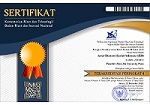Poverty Level Determination Analysis: Case Study of South Sumatra Province
Abstract
Poverty is a multidimensional problem related to economic, political, social, cultural, and community participation. This is evidenced by the increasing trend of the number of people living below the poverty line. The main trigger of poverty in Indonesia is the inequality of economic distribution or what is known as economic justice. Whereas all religions prohibit economic monopoly actions that cause injustice and order their people to give charity (zakat) and cooperate evenly. Intending to reduce the poverty rate of the community even though we still often hear of hunger and hardship for some humans. This means that the welfare that is expected and aspired to has not been realized for people's lives. According to BPS 2022 data, South Sumatra is included in the top 10 with high poverty rates. Therefore, this study aims to determine, explain and analyze the factors that affect the Percentage of the Poor Population (PPM) in South Sumatra for the period 2019-2022. This research method uses a panel data regression method with individual unit observations of as many as 17 districts and cities of South Sumatra province in four years from 2019 to 2022. This study uses one response variable, namely PPM, and four explanatory variables, namely the unemployment rate (TPT), average years of schooling (RLS), GRDP per capita, and human development index (HDI). The results of this study show that the fixed effect model with two-way specific effects is the best model of the panel data poverty rate. Variables that have a significant effect are GRDP. RLS. and HDI.
Keywords
Full Text:
PDFReferences
Aderma, Emarisa, et al. (2019). Pengaruh Pertumbuhan Ekonomi dan Pengangguran Terhadap Kemiskinan di Sumatera Utara. Jurnal Ekonomi Pendidikan.
Ahmaddien Iskandar. (2019). Faktor Determinan Keparahan dan Kedalaman Kemiskinan Jawa Barat dengan Regresi Data Panel. Jurnal Ekonomi Manajemen dan Akuntansi. 21(1):87-96.
Badan Pusat Statistik [BPS]. (2022). Persentase Penduduk Miskin (P0) Menurut Kabupaten Kota: Badan Pusat Statistik.
Badan Pusat Statistik [BPS]. (2022). Persentase Penduduk Miskin (P0) Menurut Provinsi dan Daerah: Badan Pusat Statistik.
Fitria Farida Sara. (2021). Analisis Regresi Data Panel Pengaruh PDRB, Indeks Pembangunan Manusia, dan Tingkat Pengangguran Terbuka Terhadap Jumlah Kemiskinan Di Kabupaten /Kota di Jawa Barat Pada Tahun 2013-2020. Journal Riset Matematika. 1(2):119-128
Baltagi BH. (2011). Econometrics Analysis Of Panel Data. John Wiley and Sons. Ed ke-5. England(UK): LTD.
Gujarati DN, Porter DC. (2010). Essentials of Econometrics. Ed ke-4. New York: The McGraw-Hill Companies, Inc.
Hasibuan Armayani Ria, R., Kartika Anggi, Suwito Aigha Firdha, Agustin Lismaini. (2022). Pengaruh Produk Doemstikregional Bruto (PDRB) Terhadap Tingkat Kemiskinan Kota Medan. Religion Education Sosial Laa Roiba Journal. 4(3):683-693.
Hsiao Cheng. (2014). Analysis Of Panel Data. Ed ke-3. New York(USA): Cambridge university press.
Hasbi, M. Z. N., & Widayanti, I. (2021). Analysis of Ijarah Contract Service Innovations in Sharia Banking Transactions. 282–290.
Ishak A Robby, Zakaria Junaidi, Arifin M. (2020). Pengaruh Pertumbuhan Ekonomi, Pendidikan, dan Tingkat Pengangguran Terbuka Terhadap Tingkat Kemiskinan Di Kota Makassar. Jurnal Ilmu Ekonomi. 2(2):41-53.
Iswanaji, C., Nafi’ Hasbi, M. Z., Salekhah, F., & Amin, M. (2021). Implementasi Analitycal Networking Process (Anp) Distribusi Zakat Terhadap Pembangunan Ekonomi Masyarakat Berkelanjutan (Study Kasus Lembaga Baznas Kabupaten Jember Jawa Timur). Jurnal Tabarru’: Islamic Banking and Finance, 4(1), 195–208. https://doi.org/10.25299/jtb.2021.vol4(1).6681
Leonita Lily, Sari Kunia Rini. (2019). Pengaruh PDRB, Pengangguran, dan Pembangunan Manusia Terhadap Kemiskinan di Indonesia. Jurnal Ekonomi, Manajemen, dan Akuntansi. 3(2):1-8.
Mankiw, Gregory N. (2012. Pengantar Ekonomi Makro. Jakarta: Erlangga.
Pramesti, Nyoman Ayu Tria, dan I. K. G. Bendesa. (2018). Pengaruh Faktor Sosial Ekonomi Terhadap Kemiskinan di Provinsi Bali. E-Jurnal EP Unud. 7(9): 1887–1917.
Rahmawati, Octavia Rahmawati, Bintaro,Suryo, Nugroho. (2019). Analisis Pengaruh Indeks Pembangunan Manusia (IPM), Tingkat Partisipasi Angkatan Kerja (TPAK), dan Pengeluaran Pemerintah di Sektor Kesehatan dan Pendidikan Terhadap Pertumbuhan Ekonomi Periode 1995-2017.
Riadi, Muchlisin. (2019). Human Development Index.
Rohmah Syafa’atur Ida, Prakoso Aji Jalu. (2022). Pengaruh IPM, RLS, TPT dan Pengeluaran Perkapita Terhadap Kemiskinan Di Provinsi Jawa Barat. Jurnal Transekonomi: Akuntansi, Bisnis, dan Keuangan. 2(6):255-266.
Rohmi Laili Misfi, Jaya Juliana Tiara, Fahlevi Reza Mahfudz. (2021). Pengaruh Pembiayaan Syarah dan IPM Terhadap Tingkat Kemiskinan di Provinsi Aceh: Analisis Data Panel. Jurnal Ilmiah Ekonomi Islam. 7(3):1409-1415.
Sianturi Grace Vania, Syafii, M., Tanjung Albar Ahmad. (2021). Analisis Determinasi Kemiskinan di Indonesia Studi Kasus 2016-2019. Jurnal Samudra Ekonomika. 5(2):125-133.
Sukirno Sadono. (2006). Makro Ekonomi Teori Pengantar. Jakarta: Raja Grafindo Persada
DOI: http://dx.doi.org/10.21927/jesi.2023.13(1).144-156

This work is licensed under a Creative Commons Attribution-ShareAlike 4.0 International License.












